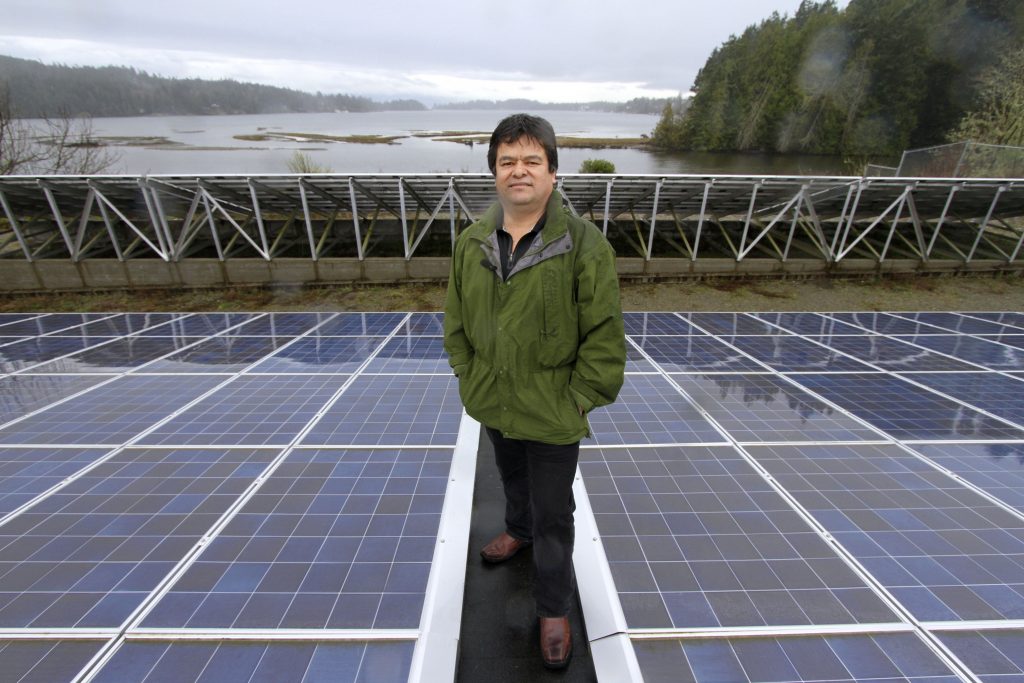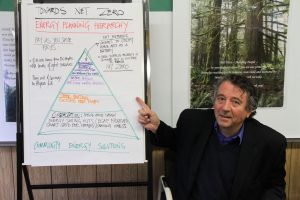By David Dodge and Duncan Kinney
During the salmon run the T’Sou-ke First Nation set up their nets on one side of the river and the bears set up shop on the other. And it’s not as acrimonious as you would think.
Respect the bear and the bear will respect you says Chief Gordon Planes. He’s the leader of this small reserve of about 250 people located about 45 minutes southwest of Victora.
It’s with this approach to the world that the T’Sou-ke developed a community plan that led them to build the largest solar photovoltaic project in B.C. and cut their energy use by 75 per cent.

Chief Gordon Planes of the T’Sou-ke First Nation on the group’s 62 kilowatt solar photovoltaic project.
“Our vision is to get back to where our people were dependent on the elements that the creator gave us, and that is the wind, the sun and the tides. We were able to use those energies in the past with a light footprint and I think it’s good for us to go full circle and come back to that because I think if anything we all need to do that,” says Planes.
The T’Sou-ke First Nation embarked on a two-year process to build a new community vision. After dozens of sessions and more than a year of process the T’Sou-ke agreed to focus on four things:
- Energy self-sufficiency;
- Food self sufficiency;
- A renaissance of culture and language and
- Economic self-sufficiency
With this vision in place the T’Sou-ke tackled the challenge of energy self-sufficiency with gusto. A few years ago they installed 75-kilowatts of solar PV on several buildings. At the time it was the largest solar PV system in the province.
Solar energy is sexy (especially when compared to things like insulation) and this project attracted money and attention. After the solar PV project there was a solar hot water project for 40 homes and then the kicker – a community energy conservation and efficiency program that cut energy use by 75 per cent.
“I often say we did our whole project backwards. We started with the photovoltaic’s, which are quite expensive…And then we suddenly realized once we had done all that, that that the key to the whole project is saving energy as opposed to producing it. So if you can save energy it costs a tenth of a price to save as it does to produce,” says Andrew Moore. Moore is a resident of the town of Sooke and a former architect from London, England who helped the T’Sou-ke develop and implement the plan.
Solar panels are a lot easier to sell than insulation, air sealing and air source heat pumps, but it really is the energy conservation that does the heavy lifting.
And engaging with solar now is a smart play. Shell Oil’s most recent energy scenario predicts that solar will comprise 37.7 per cent of the world’s energy supply by 2100.
“I think what we’re trying to achieve is something that is not just for us, it’s for all those future generations and I think that’s the key, 100 years ahead is what we always what we strive to look ahead for,” says Planes.
With significant community buy-in the T’Sou-ke started a very successful public and student education program. The students “get it more than the adults” and they are more than happy to encourage the adults to help save energy. Pulling up to the band office in your car you are greeted by small signs that say things like “Idling is fuelish.”
In the band hall there are large posters with trees on them carrying dozens of paper leaves detailing all the ways kids and adults alike have committed to saving energy. Things like “unplug my chargers,” “I will turn off the light,” and “I will ride my bike to my friend’s house instead of being driven.”

Andrew Moore helped develop and implement the strong community plan that saw the T’Sou-ke set a goal of energy independence.
The road to net-zero for the T’Sou-ke office buildings was paved with lessons learned from the energy efficiency pyramid. And while the technology is important “ the major shift that’s happened is that a real change in awareness and behavior of the community members,” says Moore.
The program also had social benefits. Nine people from the T’Sou-ke community became certified solar installers as part of the project.
If busloads of students and visiting researchers from universities are any indication folks are paying attention to what the T’Sou-ke are doing.
The T’Sou-ke are committed to the idea of education in this project so they invited all of the First Nations of B.C. to come to a gathering to celebrate their energy self sufficiency project, along with politicians from neighbouring municipalities.
The surrounding City of Colwood was so impressed they partnered with the T’Sou-ke and other jurisdictions to start the Solar Colwood Project to retrofit 1,000 more homes in the surrounding municipality to get them as close to net zero as possible.
To some the idea of spending years coming up with a community vision might try their patience. But the T’Sou-ke took their time, came up with a bold community vision and executed it with very high levels of community support. Their vision is so compelling they have students, universities and other governments looking over their shoulder and making the trek to their small reserve to see what all the fuss is about.
The T’Sou-ke are OK with all of the attention. They have even started offering add-ons like salmon feasts to the people and groups touring their near net-zero reserve. Respect the bear and there’s enough salmon for everyone.
[flickrshow:72157633210544875,width=625]
